Zagan’s Connected! Our new 4G Internet System
Fancy being able to get onto the Internet from your motorhome, anywhere, anytime? I guess lots of folks do? Being sat on a remote Greek beach, beside a German river, on a mountain pass in the Swiss Alps, even on the edge of the Sahara, and being able get online, was a fantastic feeling for us.
During our previous two year stint on the road, we updated our blog every day (almost, that bottle of Ouzo was to blame!). As we shifted about a fair bit, we needed to get online from about 500 different places. Most of the time we used the cellular (GSM) networks to do it – better known as the 3G network at the time, now being upgraded to 4G. Motorhomewifi.com have recently released a 4G system which will make this all much easier and more convenient, and we’ve just installed it.
Since coming back to the UK, we’ve dragged ourselves into the position of being able to again head off out again for some long forays into foreign parts. Huzzah! Our recent focus was on getting the right motorhome for us, and then onto massaging it to our liking with a SOG Unit and Refillable LPG tanks. We’d not much considered how we could make our Internet access better when Adam from motorhomewifi.com dropped us a line. He asked whether we’d considered a roof-mounted antenna coupled to a MiFi unit. We hadn’t, but his offer of providing the antenna for free (plus a discounted MiFi) in return for documenting a DIY install was too good to turn down (thanks Adam!).
Good roaming data packages are still hard to find (the UK Three network operator seems to have the best deal at the time of writing) but motorhomewifi may have nailed the problem of trying to get a good/fast data signal. We fitted their system yesterday to our Hymer B544 motorhome. It consists of a low-profile, but good-sized, waterproof 4G antenna which sits on top of the van, high up and outside the van’s signal-shielding metal-coated case. The antenna is connected through a hole in the roof to an unlocked Huawei 4G MiFi. The MiFi holds the SIM and connects to the mobile network via the roof-mounted antenna, which boosts the signal flowing into and out of the van. It then broadcasts a private WiFi network inside the van which allows 10 devices to share the mobile network connection.
Basically, this means for us:
- Once we’ve sourced a suitable SIM wherever we happen to be, and popped it in the MiFi, we can set the data cap in the device’s web console and track the data we’re using on its screen.
- In general use, we’ll just switch the MiFi on at the start of the day, wait a few seconds for it to get a connection, then get working/playing with the laptop, tablet etc. Yep – we also used to be able to do this sometimes with Ju’s Android-based phone and its mobile hotspot WiFi tether feature, but as often as not the signal in the van was frustratingly slow or non-existent.
The install took about 90 mins and would have been much faster if we didn’t have to remove the Sikaflex gunk from an old TV aerial installation! The part of the install which will perhaps worry most DIYers is cutting the hole in the roof. Having just cut a hole in the loo door for our SOG unit, this didn’t concern me massively. In retrospect I’d have much rather cut a new hole than have to clean up the gunk which surrounded the aerial hole! The antenna is self-sealing (it has a broad glue pad on the bottom), but as I’d had to scrape the roof a fair bit I opted to pop some silicon around the base of it after gluing it down, to help keep water out. The rest of the install really is a doddle and anyone with reasonably basic DIY skills could do it in less than an hour.
There’s a video showing the kit and the install on the OurTour YouTube channel and embedded below. Ju took photos of the install too – they’re all at the end of the post.
So far our system’s only used been used in three locations. Once in the Cooler, which is notorious for having zero mobile signal, once at Zagan’s storage site, which is a field in sight of a huge mobile mast, and once here in the car park of a village Britstops pub in Leicestershire. Each time it has connected to the network in seconds and rendered a reliable 3G connection. The tests were done with Ju’s Utility Warehouse SIM which doesn’t have 4G network. The plan is to use a Three SIM when we go to Europe in the Autumn (which motorhomewifi.com also provided to us), possibly with a local SIM or two.
The antenna feels like it was made for use as a permanent installation on a motorhome or caravan. The unit has no obvious way of allowing water ingress into the antenna itself. The large glued pad on the underside of the antenna avoids the need for Sikaflex (which works really well as an adhesive/water-proofing, but isn’t the nicest of materials to work with). The lightweight but heavy duty ceiling bolt method looks very well thought out and well matched to use with either thick or thin roofs (best to install it in a cupboard, just as you would a TV antenna). I had a scan of the Internet for anything similar and couldn’t find any equivalent ‘fixed antenna’ 4G product designed for motorhomes. The competition was generally on-a-pole install, which isn’t anything like as neat and unobtrusive a solution as this design.
The optional fixed charge unit looks handy to save tying up a 12V socket (or if you don’t have a 12V socket where you want to put the MiFi). We’ve not installed ours yet, as we want to use the MiFi for a while and see where it works best (we may want to bring it outside the cupboards so we can more easily see the screen and turn it on and off).
The kit costs at the time of writing are as follows (check motorhomewifi for the latest costs):
- 4G MIMO Roof-Mounted Antenna: £149.99
- Ridge-mount kit (we didn’t need this as our roof is flat): £15.00
- Huawei E5372 MiFi: £115.00
- Huawei MiFi fixed 12V to 5V converter and charger: £9.99
- Three SIM: £10.00 (including £10 credit providing 1GB of data for use in ten European countries)
The MiFi also has a function to pick up a WiFi signal and re-broadcast it as a new WiFi network in the van. So if you’re somewhere with WiFi which charges by device, you can share paid connection between up to ten devices. Unfortunately we can’t hook this up to our directional motorhomewifi WiFi antenna, but they have a number of booster solutions which would do such a job.
We plan to use the kit for a few months out in the field (France, maybe some Spain and Italy, who knows) then write an update review. Hey, it’s a tough job, but someone’s gotta do it. Here’s the install in blow-by-blow photos folks:
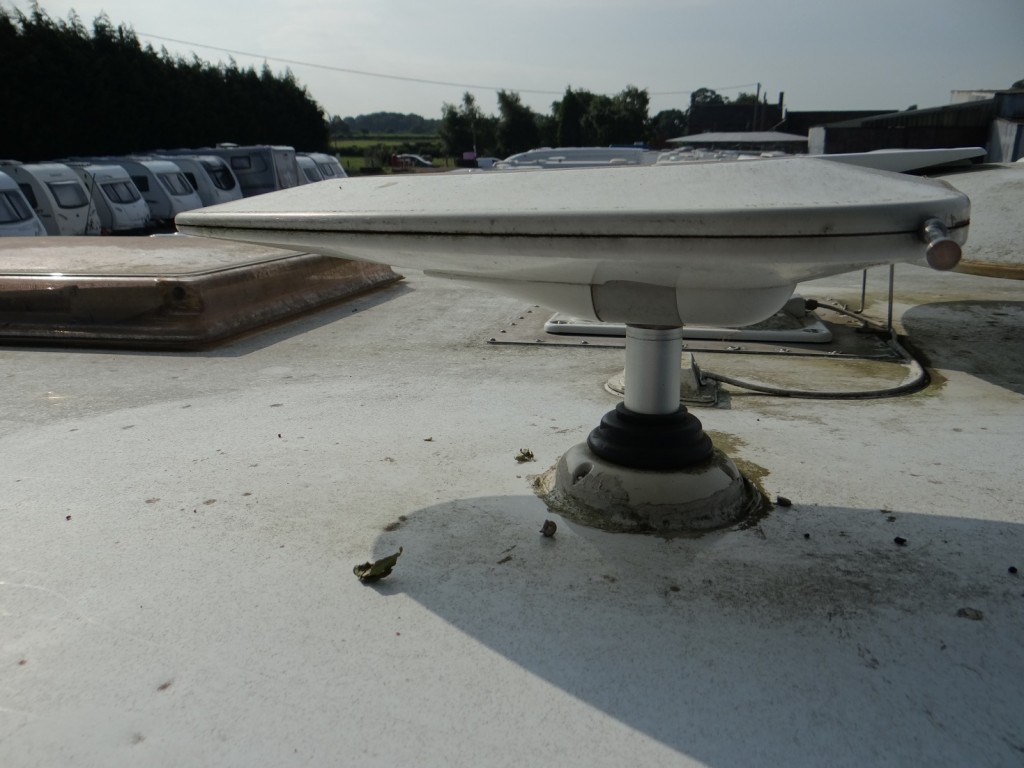
We opted to remove this Status TV antenna and place the 4G aerial in the same spot. Wise decision? Hmmm…
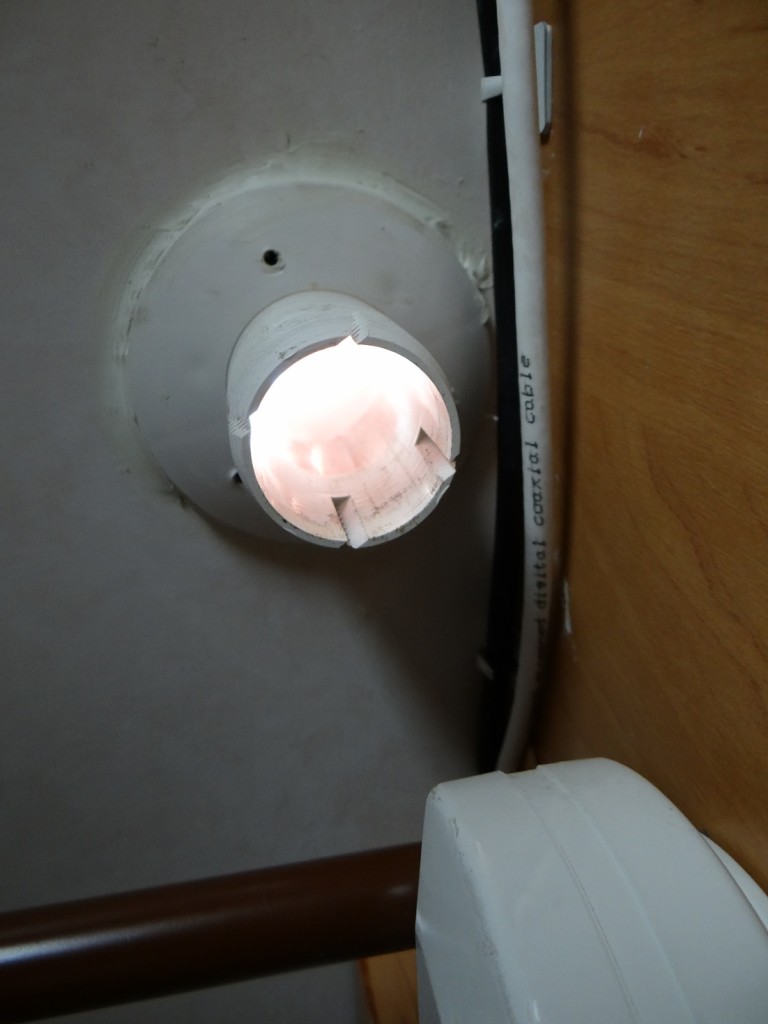
This is the underside of the Status TV antenna installation in our van’s wardrobe, with the antenna removed. The hole was much bigger than the 25mm hole suggested by motorhomewifi but this caused us no problems.
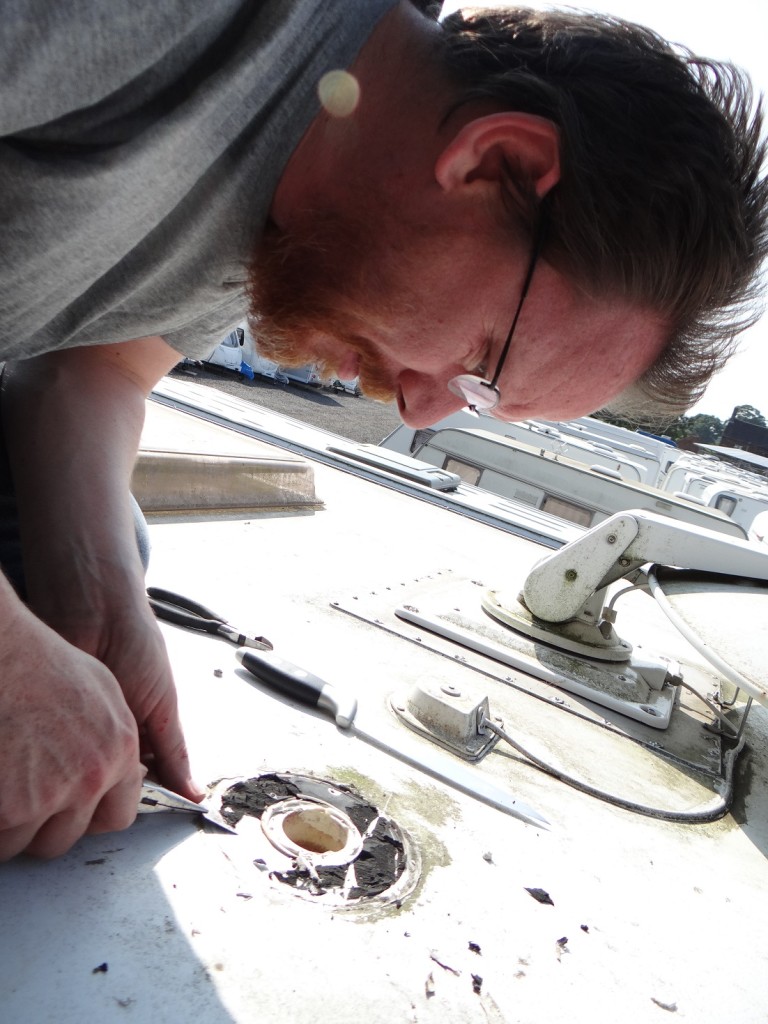
Cutting a 25mm hole with a hole saw would have taken maybe 5 minutes. It took about 30 minutes to clean the adhesive from the TV antenna hole…

Weird roof-dwelling eyeball stares down into the wardrobe! Similar gunk to remove from below to get a clean fit.
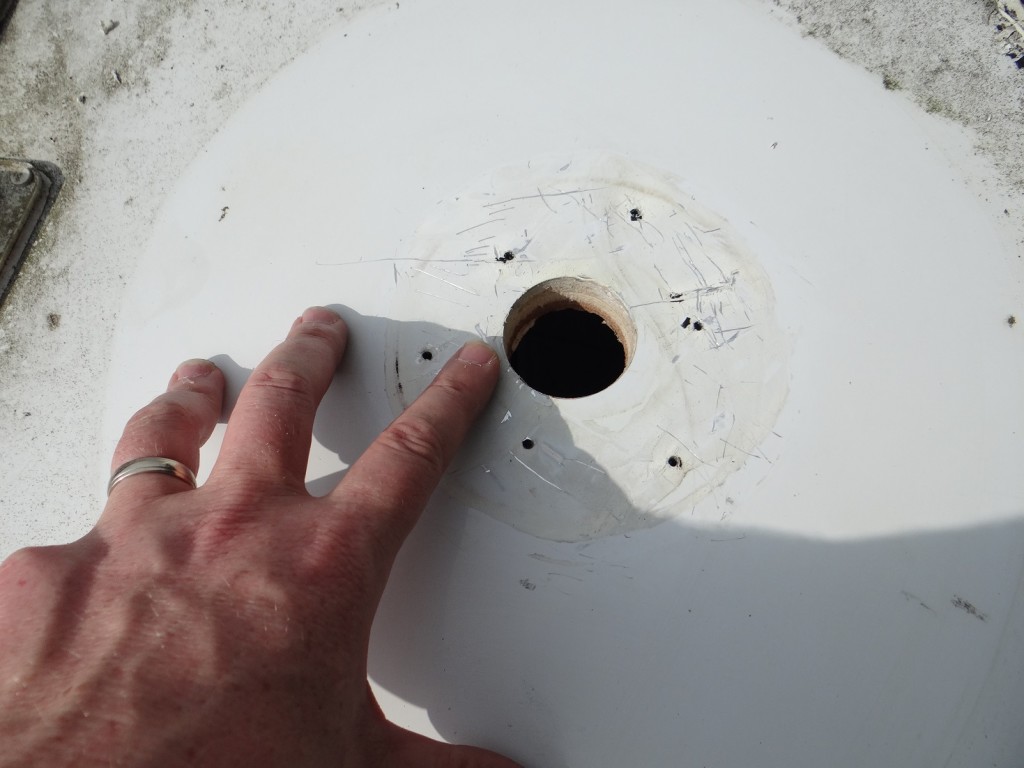
Hole cleaned up. A few scrapes in the paintwork, but this will get covered nicely by the 4G antenna.
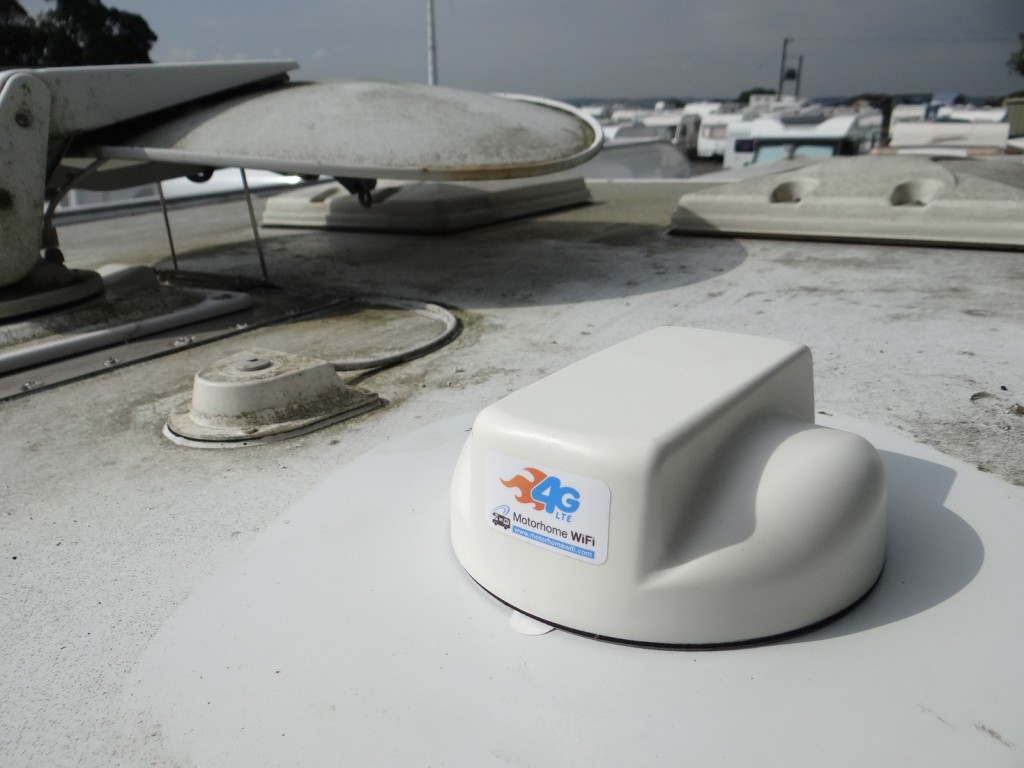
Voila! I popped the antenna in place with the adhesive backing still on to check the plate would fit onto the extension rod inside the van. I then unscrewed the extension rod to make it easier to remove the paper backing. Once I had refitted the extension rod and glued the unit in place, Ju screwed on the plate from below while I held the unit steady on the roof.
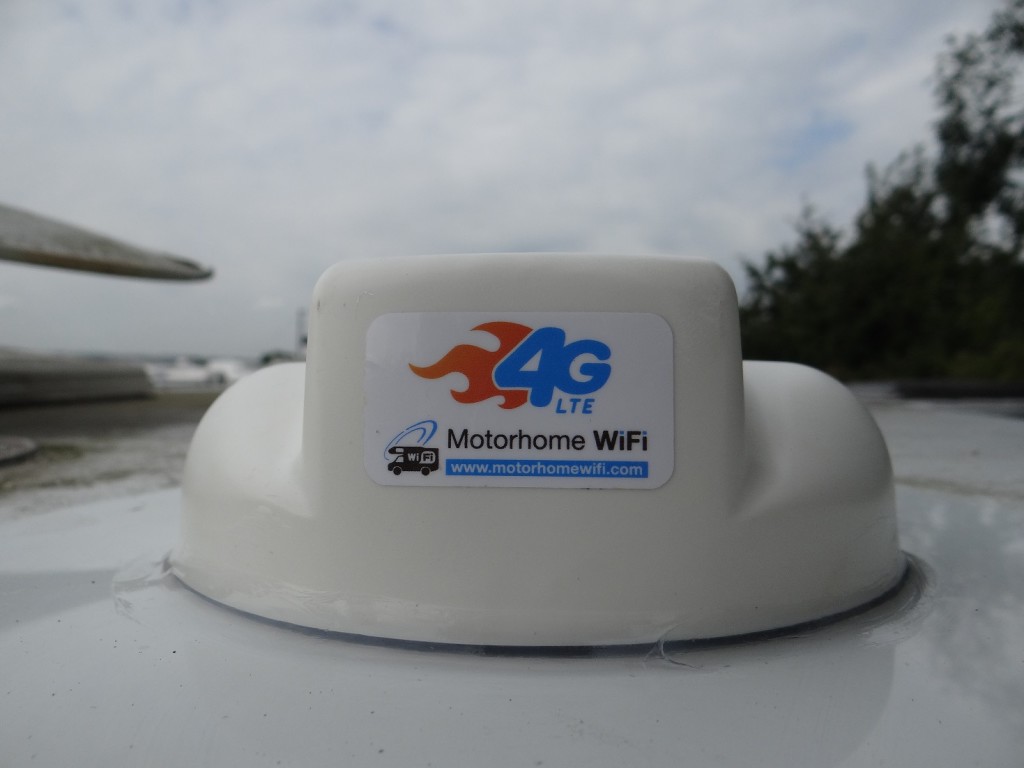
Before descending the ladder I popped a bead of silicon around the base of the antenna as a belt-and-braces to keep water out.
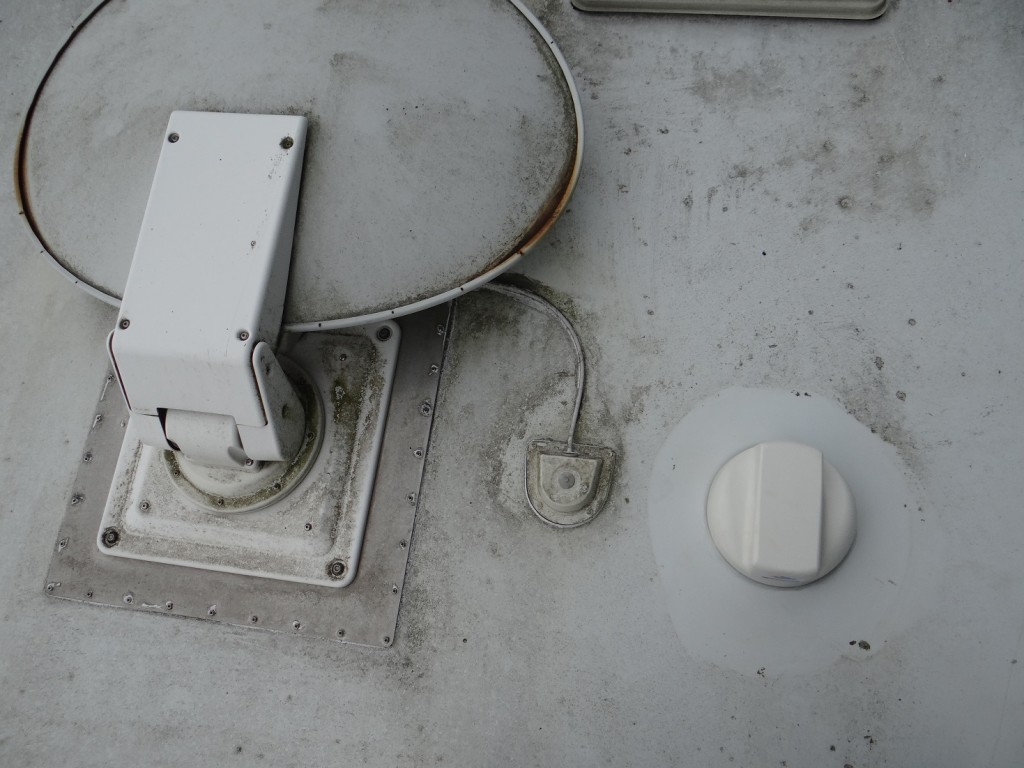
Ah. Need to clean the rest of the roof. We were off out that afternoon, so that was my excuse for doing 1/50th of the job…
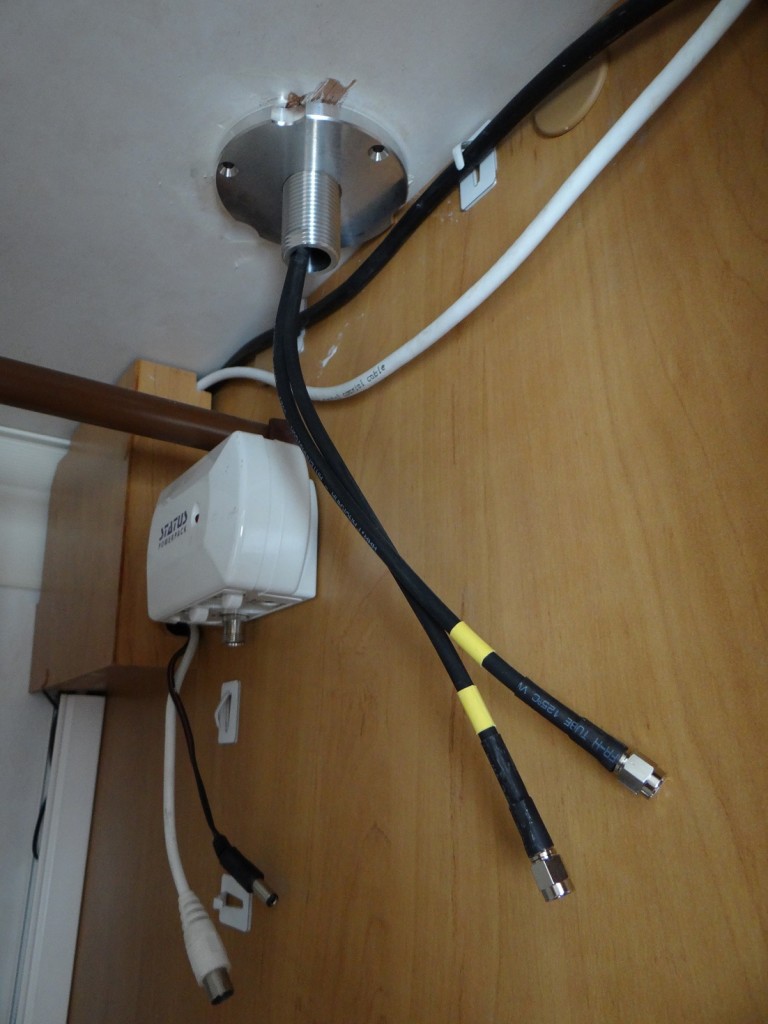
The underside of the antenna with the extension rod screwed in and plate tightened up. We popped the provided 3 screws into the plate to hold it in place.
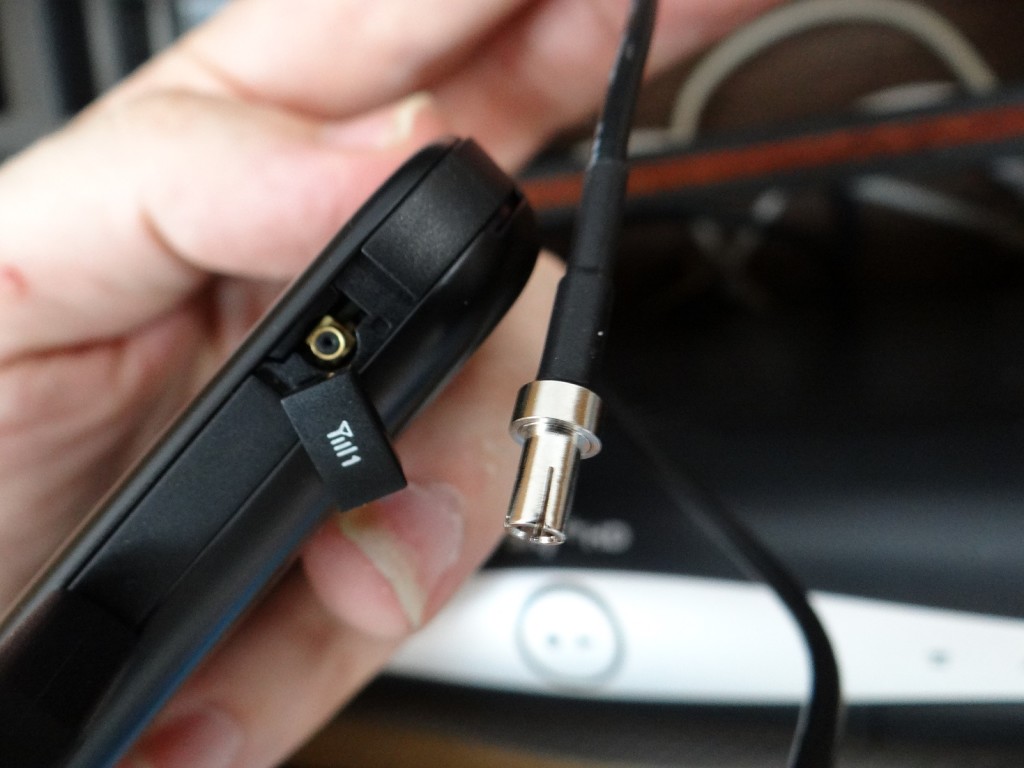
The antenna aerials were then attached and routed through 9mm holes in the wardrobe side into the TV cabinet. They both simply push into the MiFi device.
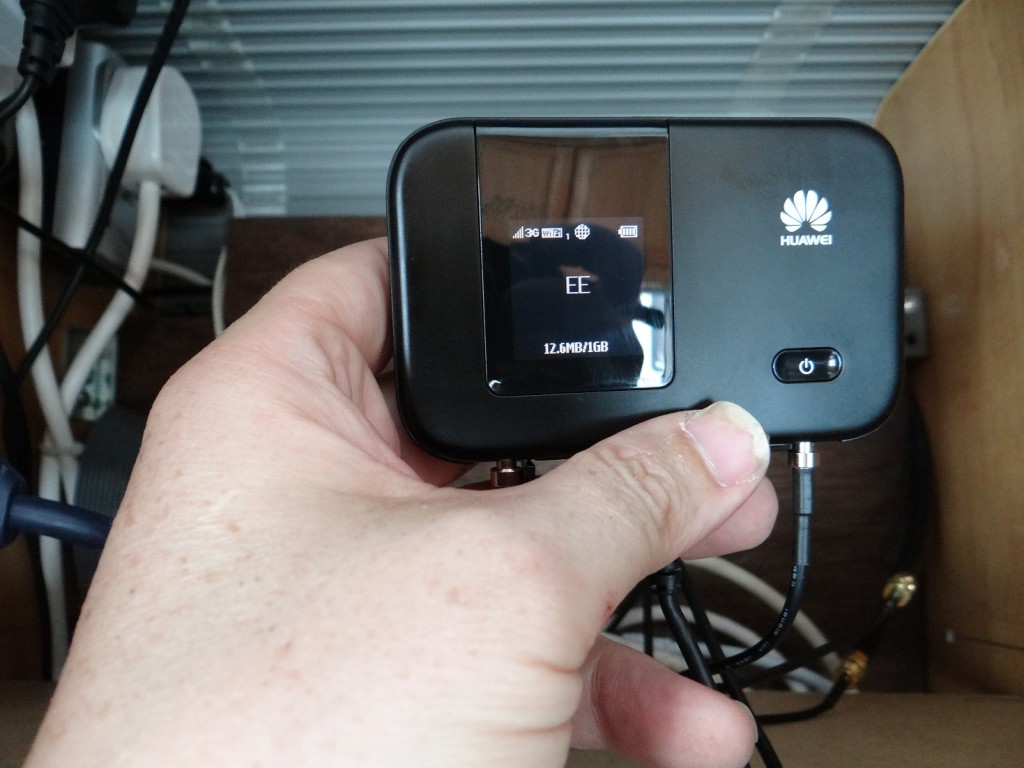
And sorted. The MiFi picked up the EE 3G network and pushed it out into the van as a secure WiFi network. We attached a couple of tablets to the WiFi network and browsed the Internet, no problem. The MiFi is plugged into a 12V cigarette socket in the TV cabinet to keep the battery topped up. Mobile Internet System: done!
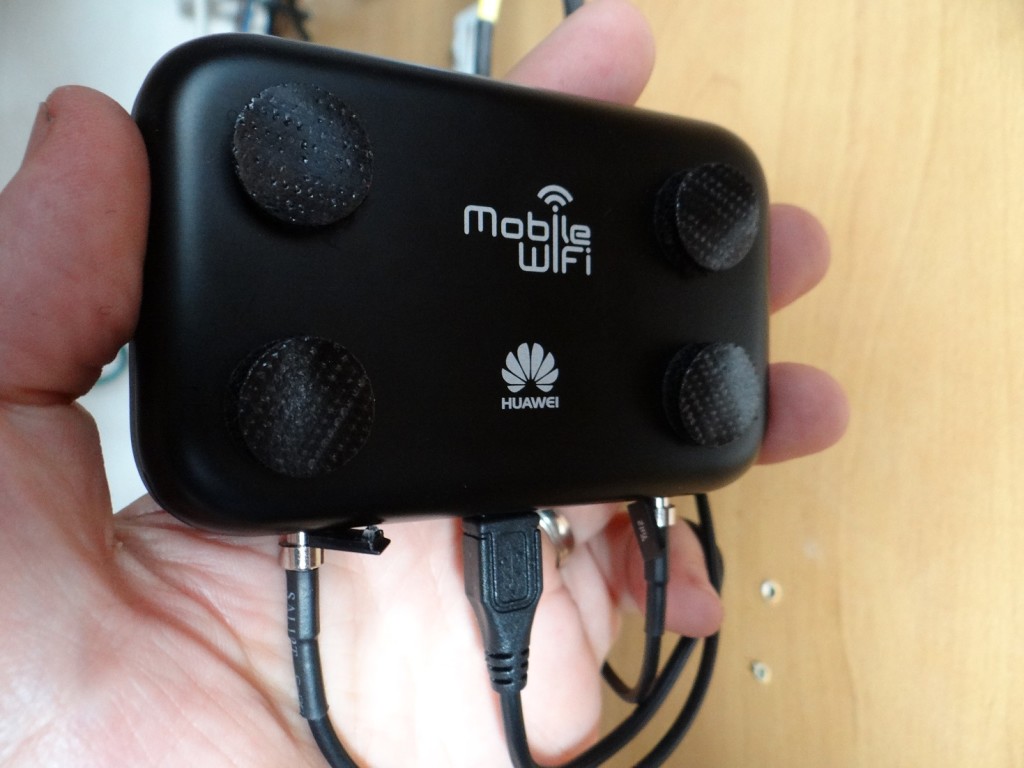
Hang on, hold your horses! Not quite done. After installing Adam advised it’s best not to use the extension cables if you can help it, to help improve the signal. I’ve therefore popped the MiFi in the wardrobe without using the extension cables, velcroed to the wall.

I’ve also attached the fixed 12V to 5v converter, connected to the back of one of the van’s 12V sockets. This has freed up the 12V socket itself for some other future use. The screen shows the battery charging. All is good with the world!
Cheers, Jay
New to motorhome life,
planning your own motorhome adventure or
looking for the perfect gift for the motorhomer in your life?
Check out our OurTour range of books.


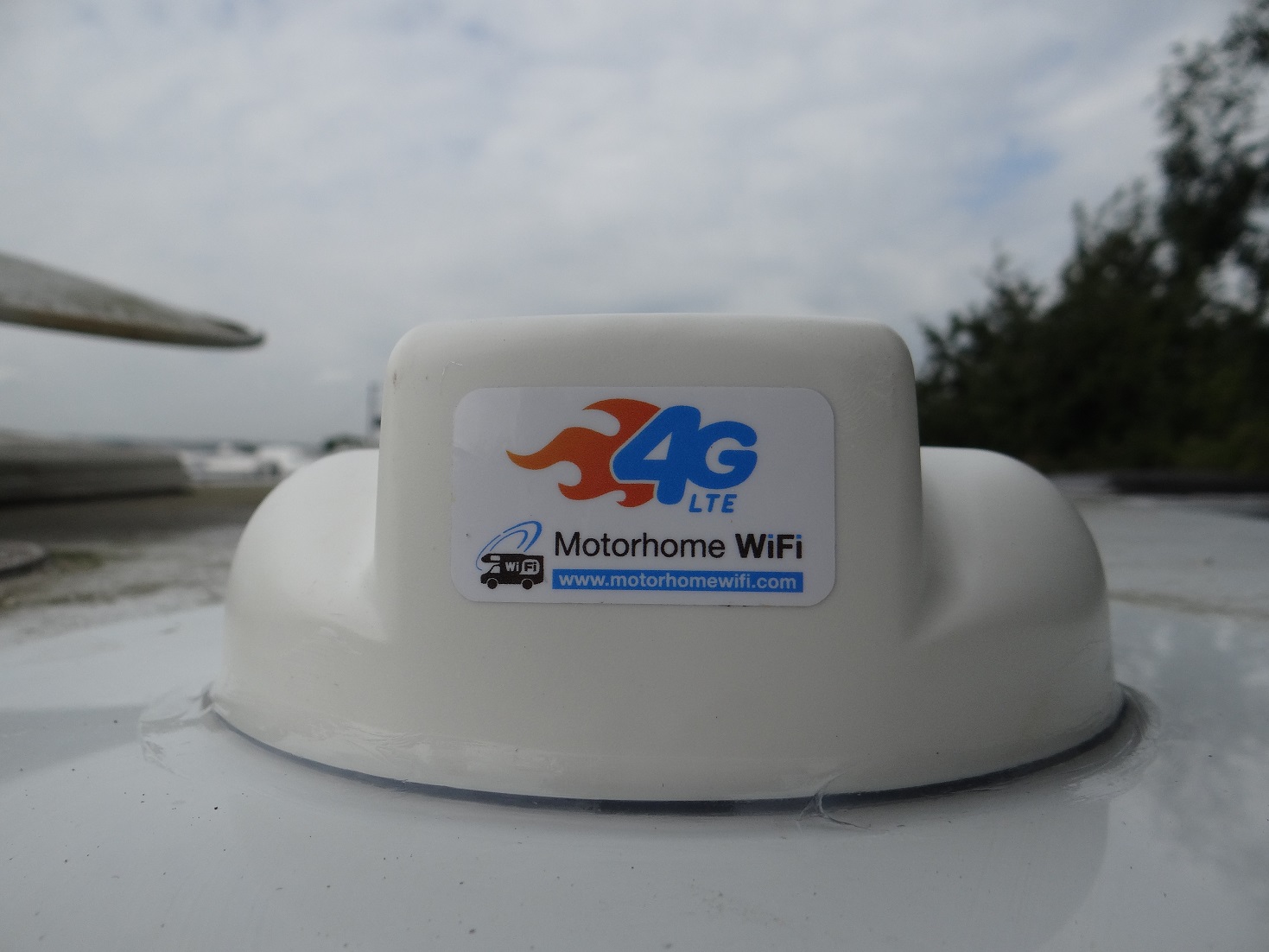

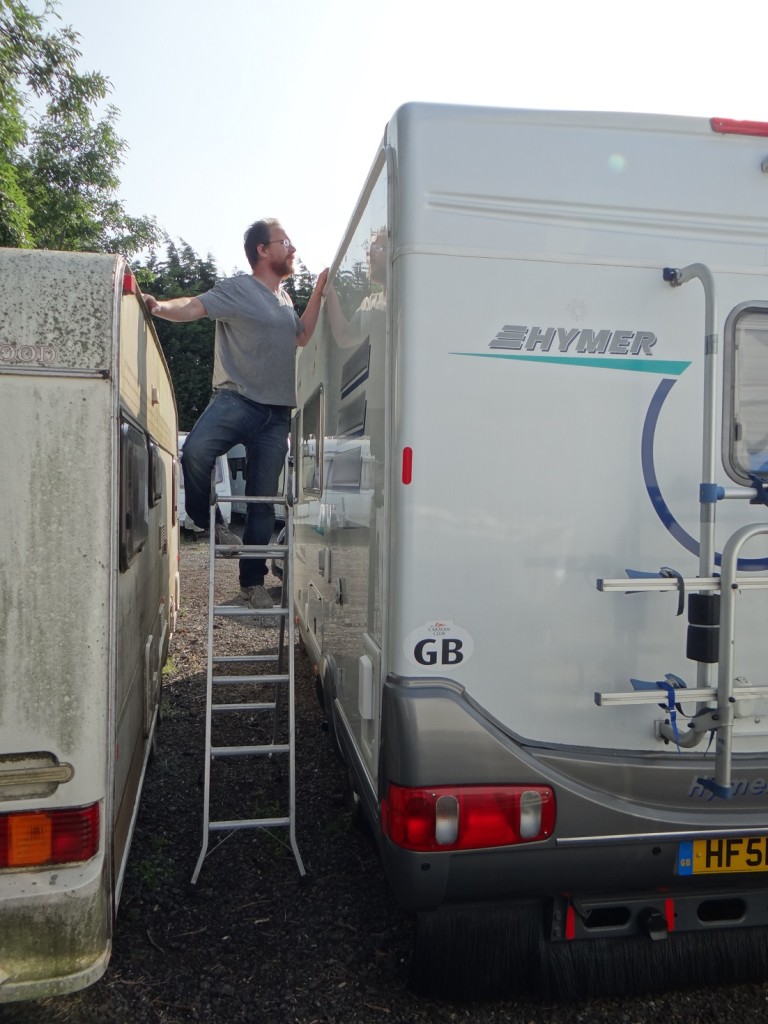
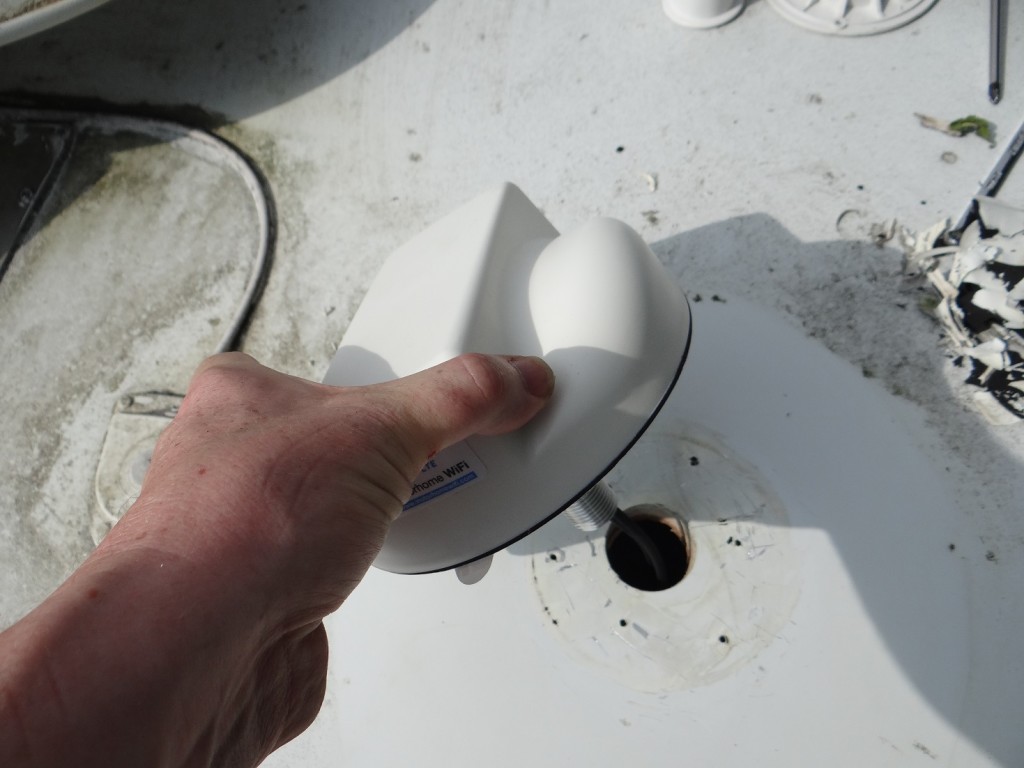









another great article, thanks. So if I have understood this rightly, this system provides wifi for up to ten users in the van whereas the alternative, eg a Three SIM card would have to be inserted into each 4g phone. So basically the same service since you are dependant on being able to obtain the right roaming cards but saves duplicating the effort? regards, Tony
Hi Tony – that’s right, spot on. The system basically shares a single SIM, but you could do that just by using a MiFi device to be honest. The other big plus, which is where motorhomewifi innovation really comes is the antenna.
I imagine many vans have one or more metal sheets built into their walls and roof – Zagan’s roof is a sheet of metal for example. These form a partial Faraday Cage, which blocks the phone signal from both getting into and out of the van. In other words, you’ll find your mobile data signal in the van is often worse than outside the van, sometimes to the point there is zero signal inside but you can get a signal just by walking outside.
By placing the aerial up on the roof, it’s higher up so less likely to be physically blocked by other stuff around you, and it’s outside the cage, so it can receive and send signals far more cleanly. It’s also physically much bigger, which I expect will increase ability to get a good signal. Just need to go some testing now!
Cheers, Jay
Helpful video, thanks. I would use a MiFi device only for the ability to enhance the signal strength with an external antenna, so I’m interested to know if this antenna offers a significant improvement. Have you managed to do any tests to check the signal strength with and without the antenna plugged into your MiFi, and does it make a significant difference on the 4G network?
Hi Paul. We’ve not used the solution in anger yet; plan to start in mid Oct and will feed back test results as we go. Watch this space. Cheers, Jay
Useful article as considering buying this aerial. Have a 3G external aerial which has always allowed us to get a signal even when nothing in the motorhome. Having said that, our Huawei mifi unit always gets a better signal than our phones even when not using the external aerial
When are you off in January 2016? I look forward to the blogs!!
Richard
Hi Richard, setting off around 25 Jan and we’re looking forward to writing them! Cheers, Jay
Hi you two. Where are you, where is our blog!!!
Take care
Richard
Hi Richard, we’re in the Alps man! Having trouble with email notifications, but if you go to the ourtour.co.uk home page, you’ll see the latest posts fella. Cheers, Jay
J and J
Just wondering how the motorhome 4G wifi system has worked out ? Can we have an update.
We will return to London and set off on another motorhome adventure soon. Connectivity between free wifi is always an issue on the road as you know but the system is relatively expensive so we look forward to your update.
Michael and Pam
Hi guys. The system has worked very well, always finding a decent 3G (we have a Three SIM so it won’t use 4G networks) signal. The only problem we’ve had is occasionally networks being very slow at certain times of the day. We’ve found waiting or switching networks manually got it going again. It’s certainly beaten our old ‘dongle on the roof’ hands down. My feeling is this is cutting edge kit in the motorhome world, hence the premium, but if you’re a heavy user like us, worth every penny. Cheers, Jay
Hi guys
Thanks for all your info – it’s very helpful! We are embarking on a similar trip to yours, with no plans to settle for a while… Wahooo!! We’re about to fit one of these on our motorhome. I’m just wondering how you manage the rotating of “three” sims. What deals do you go for, how long do you use each sim, do you get different network sims within the country your travelling etc. How do you stay within the roaming rules of the sim? Hope you’re having great times and look forward to hearing from you! Catherine and Shelley
Hi Catherine and Shelley
Quick answers below:
1. We buy a few 3 PAYG pre-loaded SIMs, about £30 for 12GB on eBay, Amazon etc (shop around). These last for 12 months in the UK, but only 2 or 3 months abroad (not sure what the latest restriction is). 3 didn’t adhere strictly to the time limit for us.
2. We bought local SIMs in countries where the 3 SIM was not valid (Morocco for example) or where we could get a better deal on data locally. All local SIMs are different to buy, set up and top up; sometimes a real pain without local language skills!
3. For the 3 SIMs we just keep a record of the countries it can be used them, and make a note of the date we started using them.
Cheers, have fun! Jay
Jay
Thanks for your response. We normally pick up a local sim in whatever country we are visiting, but then there are the issues of operating it through an unlocked dongle inside the Hymer. We have found the only spot it will work is by placing it up in the main roof vent, then there’s the hassle of keeping it charge etc. I notice Motorhome Wifi are now indicating the mifi can be managed through an app on the iPad so all the better.
Anyway thanks again.
Any update? How did it work on the continent? Were you able to get 4G there? With a UK SIM or did you have to get a local one?
BTW, this wiki is very useful: http://prepaid-data-sim-card.wikia.com/wiki/Prepaid_SIM_with_data
Hi Kent, we’ve used the system for almost 2 years of touring across Europe and North Africa and it’s performed really well. Much of the time we’ve used Three PAYG SIMs, which don’t connect to 4G networks, but when we’ve used local SIMs we’ve had lightening fast LTE access. Cheers, Jay
Jay,
Thanks for all that; interesting and useful.
I’d like to know your view about 4G data usage. Up to now we’ve been entirely dependent on wi-fi in a rented property but expect to soon be on the road and away (in Europe) for months at a time. I’ve no idea what our normal GB per month usage might be. We do what might be “the usual things”: check e-mail and news sites, use Skype and camper apps, watch quite a lot of YouTube, and there’s some study which requires being on-line. Looking at a particular plan – Vodafone, because of what I understand to be the unlimited European roaming – the options include 15-, 30- and 50GB, costing 20, 25 and 30 pounds p.m. respectively. I don’t know which one to go for. What might be your advice?
Hi Samuel. Tough one to answer as it’s hard even for us to know how much we’re using when on WiFi. It’s only when we’re metered on 4G that we start to take notice, and usually alter our behaviour to use less data. One option would be to start with 15GB, track your use each day on Vodafone’s website and upgrade your plan if you need to? Cheers, happy travels, Jay
Hi Jay and Julie.
Many thanks for your blogs. Have you heard of the Three sim that gives Unlimited, Data, Text and Calls, for £20 pm. Only limited to Three’s usual 19GB in Europe. I have bought one, looking to use it in France etc. I don’t stream video’s etc, just normal browsing, searching, and was wondering if I need to use a MiFi. I was going to use my iphone 7 as a Hotspot, without a dongle. What are your views as you are much more experienced than I will ever be.
Hope you are having better weather than we are in UK at the moment.
Brian.
Hi Brian – yep, we’ve used these for a few years and have one with us as a back-up. As I understand it you don’t need a MiFi but can share out the 3G connection via a WiFi hotspot as you plan (check with 3 to be sure). These 3 ‘Internet with Legs’ SIMs have served us well across most European countries, but we now shifted to Vodafone as our main SIM. More info in this blog post:
https://ourtour.co.uk/home/best-sims-for-roaming-internet-in-europe-2019/
Cheers, happy travels! Jay
Hi Jay We are considering strongly getting one of these but have a couple of questions and as you fitted yours and have the experience of using MiFi I am hoping you can help. Do I assume correctly that to use the MiFi and TV you are using 2 12v sockets (1 for the MiFi and 1 for the TV)? I saw from the Amazon Firestick video that the TV didn’t have the power to run the Firestick. Was the USB plug an extra you fitted/had fitted? And finally, we have 1 auxiliary battery, in your experience of using the system (we also have a RoadPro TV dome and solar panel) would 2 auxiliary batteries be better? We have a Panel Van so won’t be fitting myself but just want to get things clear in my mind before contacting Motorhome MiFi. Thanks for any help you can give. Paul
Hi Paul
I’ll do my best to answer mate:
1. The MiFi from motorhomewifi.com came with a 12V charger which I’ve wired direct into a 12V supply (I connected it to the back of an existing 12V aux socket). It didn’t have a USB connection on it, although I don’t see why you couldn’t just use a USB cable if you have a suitable USB socket available.
2. The TV is plugged into a 12V aux socket extender, which had a USB converter in it, which we use for the Fire TV Stick, something like this adapter on Amazon: (affiliate link here).
3. The battery capacity question’s really difficult to answer – really depends on the size and condition of your current battery, how often you drive, whether you spend time in sunnier climates, how often you hook-up, whether you’re running your gas heating fan much and so on. I’d try using the kit as you are with a single battery, and if you struggle then get a second one (you may need to replace the existing one and pair two new batteries together – I’m no expert on this).
Cheers, Jason
Thanks Jay for taking the time to reply I appreciate it and now I understand a bit more. Thanks Paul